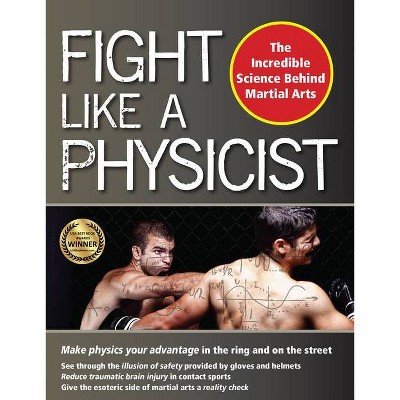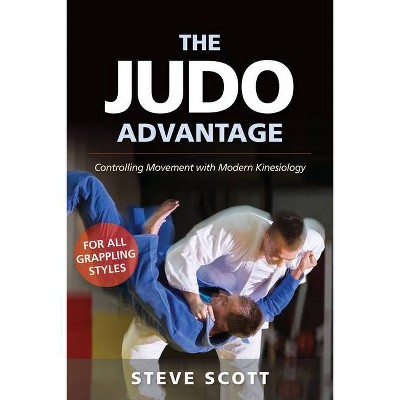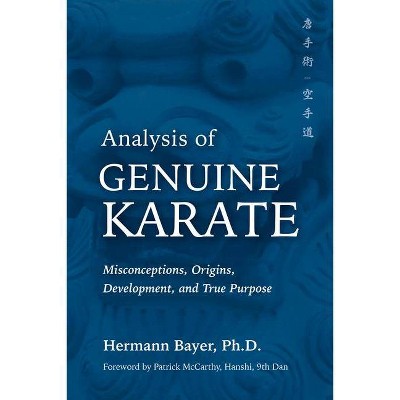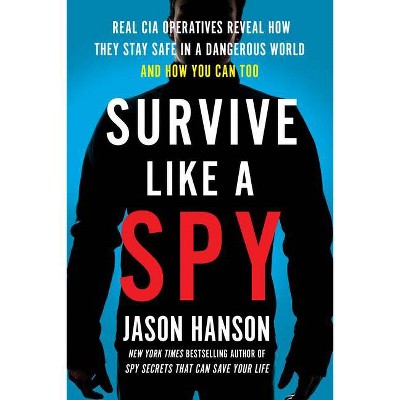Fight Like a Physicist - (Martial Science) by Jason Thalken (Paperback)

Similar Products
Products of same category from the store
AllProduct info
<p/><br></br><p><b> About the Book </b></p></br></br>An in-depth, sometimes whimsical look into the physics behind martial arts for sport and self-defense. Experienced martial artists or curious enthusiasts, this book can give you an unfair advantage by unraveling the science of fighting techniques and examining the core principles that make them work. You will learn the truth about the illusion of safety provided by gloves and helmets, aiding you in reducing traumatic brain injury in martial arts, boxing, and contact sports.<p/><br></br><p><b> Book Synopsis </b></p></br></br><p>An in-depth look into the physics behind martial arts. Whether you are an experienced martial artist or a curious enthusiast, this book gives you an "unfair advantage" by unraveling the complex science of effective fighting techniques and examining the core principles that make them work. Did you know?</p> <ul> <li>Momentum is for knocking people over </li> <li>Energy is for breaking bones and causing pain</li> <li>A haymaker travels 3.14159 times farther than a jab</li> <li>You are only an "object" when you are rigid</li> </ul> <p><i>Fight Like a Physicist</i> blends inquiry, skepticism, and irreverent humor--all while punching holes in myth and mysticism. Highlights include</p> <ul> <li>Making physics your "unfair advantage," in the ring and on the street</li> <li>Examining center of mass, pi, levers, wedges, angular momentum, and linear momentum for martial artists</li> <li>Reducing traumatic brain injury in contact sports</li> <li>Exposing the illusion of safety provided by gloves and helmets</li> <li>Overturning conventional wisdom on compliance during an assault</li> <li>Busting up Hollywood action clichés</li> </ul> <p><i>Fight Like a Physicist</i> reads like a manifesto on the rational practice of martial arts. It's intelligent, fun, and dangerous--and nothing short of iconoclastic.</p><p/><br></br><p><b> Review Quotes </b></p></br></br><br>Thalken explores how physics can be applied to martial arts. More than a body of facts, Thalken sees physics as a practical discipline: an approach that can be applied to any number of pursuits. His chosen pursuit is martial arts. As in physics, the author says, no authority or status can make a martial artist's technique effective. Testable and reproducible results hold all the power. His thesis is that by understanding the way the human body moves and balances, a martial artist can gain the upper hand on opponents who do not approach their sport scientifically. Thalken outlines the way concepts from physics reveal strategies in fighting--the center of mass is important for leg sweeps and grappling, hits that travel shorter distances will arrive with greater force and speed, etc. He also debunks common misconceptions about equipment. For example, boxing gloves are not "safer" than bare knuckles; while they distribute force over a wider area, causing fewer breaks in the skin, they allow the fist to strike with more momentum and hit hard surfaces (like the head) more frequently. He also delves into many of the myths propagated by media portrayals of martial arts as well as the pseudoscience propagated by practitioners of martial arts themselves. A relatively short book, the work is more primer than instruction manual, advocating a perspective as opposed to promoting individual exercises or training regimens. There is an infectious energy to Thalken's prose, one that sells both the no-nonsense combat analysis and the cool skepticism of the physics discussion. As a guidebook, the text has very little fat: section titles like, "Where Is My Center of Mass, and Why Do I Care?" keep readers assured Thalken isn't trying to force more information on them than needed. The author is an apt communicator of even the more abstract ideas, putting them into a simple, intuitive context. It's unclear if thinking like a physicist can actually win a fighter matches, but it certainly provides a new grammar for thinking about the ways in which our bodies move. An enlightening book for martial artists seeking a competitive edge.--Kirkus<br><br>Fight Like a Physicist is a cool concept that makes physics tangible for fans of fighting sports. As a martial arts practitioner with a doctorate in physics, Jason Thalken has an interesting perspective on fighting sports, and he applies his knowledge of scientific principles to his chosen sport in Fight Like a Physicist. Though there probably isn't quite enough material here for a full book, the early sections do a solid job explaining the physics in a relatable way that gives fighters some perspective on how to incorporate scientific knowledge to fight better. Fight Like a Physicist finds a nice middle ground in terms of the material's tone --the writing is simple enough for its target audience to understand and apply, while it still delivers meaningful scientific concepts. For example, the book uses levers as a way to explain the relationship between distance and force, and explains how the dispersal of force on impact can make particular blows more or less effective. Thalken includes numerous charts and graphs throughout the book. Like many of the concepts he writes about, these visual representations will look familiar to anyone who took physics in high school, but may not have thought about the material since then. He throws in the occasional "math box," to highlight mathematical concepts like the force curve or the center of mass, while using both equations and sample fight-based scenarios. Combined, these elements make Fight Like a Physicist both a useful primer and an enjoyable refresher. Though the early chapters are strong, the book does lose its way a bit late, with chapters that seem shoehorned in. Thalken includes a chapter about brain injuries affecting football players (including Chronic Traumatic Encephalopathy), and posits a theory about how applied force might manifest in such injuries. However, the author also has a patent pending on a new helmet--which he discloses honestly, but which does make an already tangential chapter feel like a sales pitch at times. Other sections criticize practices like tai chi for their lack of scientific basis, or advocate fighting back against criminals in dangerous real-life situations, but these parts feel unnecessary, and the tone deviates from the book's strengths. They don't quite fit the fighting-sports theme, and the science in these chapters is less than clear cut, especially when compared to the universal principles discussed earlier. At its best, in the early chapters, Fight like a Physicist is a cool concept that makes physics tangible for fans of fighting sports, and can just as easily get more science-minded readers interested in those sports.--Jeff Fleischer "Foreword Reviews, March 12, 2015 "<br><p/><br></br><p><b> About the Author </b></p></br></br>Jason Thalken has a PhD in computational condensed matter physics from the University of Southern California, and bachelor's degrees in physics, mathematics, and philosophy from the University of Texas. He is the inventor on eight patent applications for data science and modeling in the financial services industry, and one patent application for protecting the brain from trauma in such sports as boxing, MMA, and football. Jason has studied and competed in numerous martial arts styles since 1995 and has a black belt in hapkido under Grand Master Ho Jin Song. Jason Thalken resides in Seattle, Washington.
Price History
Price Archive shows prices from various stores, lets you see history and find the cheapest. There is no actual sale on the website. For all support, inquiry and suggestion messages communication@pricearchive.us




















